Gregory Crouch's Blog, page 41
December 14, 2011
Pearl Harbor, a colossal blunder?
December 7 just passed, and it always sets me to thinking… I ponder the day and the terrible war it set in motion. My mind's eye sees the Japanese strike force sweeping over the North Shore of Oahu unleashing death and chaos on Pearl Harbor and its surrounding airfields. It was a truly spectacular display of combat prowess, demonstrating in horrible glory the newfound power of naval aviation. U.S. losses were heavy: eight battleships and eleven other warships had been sunk or badly damaged; two hundred American airplanes destroyed on the ground and another hundred damaged; 2,400 Americans dead.
(National Geographic has an excellent "attack map" here. It's worth checking out.)
The Pearl Harbor attack was an astounding operational success, and it forever shifted the shape of naval warfare. It also strikes me as one of the greatest strategic blunders of modern times.
Enraged, the United States declared war on Japan the next day, committed in an instant to the new enemy's total evisceration. Japan had provoked a total war with the one nation on earth that within a mere three and a half years — using only the left had of its power (the bulk of American combat power would end up arrayed against Hitler's Germany) — would have the ability to exterminate Japanese civilization.
Nevermind the shortcomings of the Pearl Harbor raid –the survival of the American aircraft carriers or of Pearl Harbor's repair and fueling capabilities — considering the enormous gulf between American and Japanese industrial potential, it's hard to imagine ANY scenario in which the Japanese would have won the war considering that the Pearl Harbor attack had instantly committed the United States to a quarrel that could only end in"their overthrow or ours" (to steal a bit from Winston Churchill's Christmas 1941 address to Congress.)
As I understand the Japanese plan, they knew they couldn't overcome American industrial might in a protracted conflict, so their strategy for the opening of the war was to inflict such a crushing defeat on the United States that we'd feel hopeless and loose the will to fight back and would sue for peace, leaving Japan in position to dominate Asia.
It's hard to imagine a more colossal miscalculation, a more enormous failure to "understand the enemy."
It also begs several questions: why might they have thought that the US lacked the stomach for war? What alternative course or courses of action might they have pursued to achieve their end?
December 12, 2011
The lone flush toilet in Chungking
Ernie Allison "checked out" Moon Chin in June, 1936, qualifying him as an airline captain competent to command his own plane. It was a big promotion, and much responsibility for a twenty-three year old. Moon Chin's salary doubled, and Moon's girlfriend, Elsie, suddenly wanted to get married.
Moon Chin borrowed $500 to make it happen, and they married in the Community Church at 53 Avenue Petain in the French Concession on May 10, 1936. Bondy and Kitsi attended, along with much of the company staff. Afterwards, Ernie Allison assigned Moon Chin to fly the Chungking to Chengtu line and sent the newlyweds upriver. The move started badly for Elsie. She burst into tears when she reached Chungking and discovered that there was only one flush toilet in the entire city, in the visitor's quarters of the Bank of Chungking. The toilet had no door, it faced the stairway, and Harold Bixby considered it "about as private as the information booth at Grand Central Station." Moon Chin and Elsie moved to Chengtu, where the plumbing was no better, but it made more sense to base the air service's pilot from that town. They rented a suite of rooms from a Szechwan general.
[i] Author's interview with Moon Chin, September 17, 2004 and July 15, 2005.
[ii] Community Church at 53 Avenue Petain: All About Shanghai and Environs: A Standard Guidebook, The University Press, Shanghai, 1934-1935 edition, text online at http://www.earnshaw.com/shanghai-ed-i....
[iii] "and Chin Moon-fun, we saw his wedding": Bond to Kitsi, Saturday, August 28, 1937, written in Hong Kong on Peninsula Hotel stationary, the Bond Papers.
[v] The only flush toilet in Chungking, and it being "about as private as the information book at Grand Central Station:" Harold M. Bixby, Topside Rickshaw, Ch VIII, pp. 7
December 8, 2011
Moon Chin's favorite airplane-the Douglas Dolphin
This continues from the end of the CNAC and the Long March post…
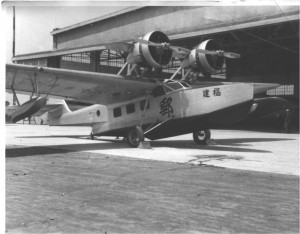
The Douglas Dolphin at Shanghai's Lunghwa Airport
The importance of the Kweichow/Kunming line faded after the Communist escape, and Chief Pilot Ernie Allison returned Moon Chin to Shanghai to fly the Douglas Dolphin on Route Three, between Shanghai and Canton. Powered by two Pratt & Whitney R-985 radial engines, each delivering 450 horsepower, the Dolphin had more power than it needed, making it unique among the seaplanes of the day. (Of all the airplanes Moon Chin flew during his career, the Douglas Dolphin is his favorite.)
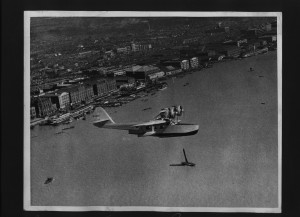
The maiden flight of CNAC's first dolphin; over Shanghai in 1934 (Edward P. Howard photo)
The Dolphins' wings were skinned with plywood, and the nails tended to loosen with the impact of each water landing. One of Moon Chin's copilot duties was to nonchalantly walk along the wing top after each landing and use his boot heel to discretely shove the nails back into place.[i]
The Dolphin's biggest flaw was that it had been designed without a water rudder, and Bixby wired Andre Priester, Pan Am's chief engineer, detailing the oversight and asking for a fix.
Priester cabled that the Douglas Corporation would design one for $2,500 U.S.
To hell with that, thought Bixby. He designed one himself on the back of an envelope, which worked fine, and all it cost C.N.A.C. was six Chinese dollars, including installation (worth about $2 U.S.).[ii]
Pan Am tried to lord it over its China subsidiary, but New York didn't seem to realize that the China flyers were pilots of extraordinary competence who accumulated vast quantities of experience in difficult conditions with little of the operational hand-holding available to pilots in the United States.
[i] Moon Chin's stories of the Douglas Dolphin: author's interviews with Moon Chin; Moon Chin Oral History, Louis A. Turpin Aviation Museum.
[ii] Bixby and the Dolphin's water rudder: 1957 interview with Harold Bixby, the Pan Am Archive, Box 20, Folder 1.
December 7, 2011
What #1 bestselling author James Bradley has to say about China's Wings
Yesterday was a big day. Working back and forth with my editors at Bantam, we closed the last detail. China's Wings is finished. Took seven and a half years to research, write, and edit – four to five YEARS longer than I originally anticipated — but it is at last finished and will be off to the printer after the New Year. Alea jacta est. I sincerely hope I've done CNAC's story justice.
Tracy Devine, my excellent and delightful editor, also received a brief review from #1 New York Times bestselling author James Bradley, he of Flags of Our Fathers, Flyboys, and The Imperial Cruise. (She'd sent him a galley to read and review.) This is what he wrote:
"In China's Wings, Gregory Crouch recalls the remarkable encounter between an ancient civilization and the most modern technology in the world, as intrepid Americans [and their Chinese partners] struggled to establish a sophisticated air network over a vast land that barely knew electricity. This gripping book will transport you to a fascinating lost time."
Thank you Mr. Bradley. So glad you enjoyed it.
It's also worth noting that on this day in 1941 (December 8 on the other side of the International Date line, in Hong Kong), CNAC's base at Kai Tak Airport was bombed by the Japanese at about 8 o'clock in the morning. The intensely dramatic events of 8-10 December, 1941 comprise one of my favorite chapters in the whole book.
December 6, 2011
CNAC and the Long March
This is a continuation of the "gas streetlamps sputtered…" anecdote I began yesterday. It's probably worth reading them in sequence…
…Bond and Bixby worked until two o'clock in the morning, trying to figure what airplanes to use and how to allocate them to satisfy the Central Government's demand. Bixby didn't know it, Bond didn't know it, and not a single one of CNAC's directors knew it, but it was surely no coincidence that eighty-six thousand soldiers of the Communist Red Army began crossing the Yadu River that day, leaving their Kiangsi Province base and heading west, taking the first steps of a year-long, 7,000-mile odyssey that Communist lore would remember as "The Long March."[i] Chiang Kai-shek's "blockhouse strategy" had forced the Communists to move. The best units of Chiang's Central Army had spent most of 1934 building a ring of military fortifications around the entire Communist base area and advancing slowly, at the rate of forward construction, to squeeze the stronghold from all sides.[ii] By the autumn of 1934, the Communists knew they'd be annihilated if they didn't slip the Nationalist chokehold. Kweichow and Yunnan provinces lay athwart their probable westward escape routes.
For the Kuomintang, it was the best chance they'd had to eliminate the Chinese Communists since the Shanghai White Terror of 1927, and Kuomintang leadership conceived the Kweichow-Yunnan airline as a lever with which to help them exert influence in the two provinces, places where they'd previously exercised very little power. Chiang Kai-shek flew to Kweiyang to try and convince the local warlords to help him crush the Communists.[i] (Official correspondence always referred to warlords with the face-giving title of "military governors").
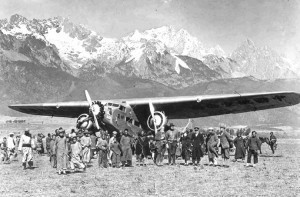
Ford Trimotor in Yunnan Province in 1936 (courtesy of cnac.org and Bill Larkins)
Few people were aware of the military situation — certainly not anyone on the CNAC board. Bond, Allison, and Bixby just knew that the proposed Kweiyang/Kunming line traversed high mountains devoid of emergency landing opportunities and therefore demanded a sturdy, reliable, multi-engine airplane that could hold 6,000 feet of altitude if it lost an engine. They decided on the Ford tri-motor, an all-metal, high-winged monoplane nicknamed the "Tin Goose" that resembled an overgrown Stinson with one engine on the nose and one planted on each wing. It was built by the Ford Motor Company of Detroit, Michigan, the same company that had given the world the Model-T automobile.
A pilot became more valuable the more planes he was competent to fly, and Ernie Allison assigned Moon Chin as a Tin Goose copilot. Moon Chin flew baled loads of Chinese banknotes and many members of Chiang Kai-shek's staff to Kweiyang, the capital of Kweichow Province, and, at the behest of many important Kuomintang officials, Moon flew the goose on a variety of "special charters" in the region as the Communists skirmished west, marching and countermarching all over Kweichow to confound the Central Army. The Communists feinted north to threaten Chungking and then fled west into Yunnan. At the height of the campaign, the Kuomintang Aviation Commission (the agency that controlled the Chinese Air Force) tried to bully CNAC into carrying bombs and ammunition to Kweiyang, but Bond and Bixby decried CNAC's commercial character and used the American neutrality tradition to evade the clearly military assignments.[ii]
Chiang Kai-shek failed to trap the Red Army. The Communists escaped across the Yangtze in Yunnan and streaked north along Szechwan's western frontier, eventually finding safety in the remote mountains of Shaansi Province, far to the north. The importance of Kweichow faded after the Red Army escape, and when the Central Government stopped the Kweichow subsidy, the airline quietly dropped the unprofitable stop.
[i] Developing the Kweichow/Yunnan Line; its attendant politics: Harold M. Bixby, Topside Rickshaw, Ch. VIII, pp. 4-21; Jonathan D. Spence, The Search for Modern China, pp. 407, confirms CKS's personal visit to Kweiyang.
[ii] Moon Chin flies the Tin Goose: author's interview with Moon Chin, January 7, 2005; July 15, 2005; C.N.A.C.'s service during the Long March: Bixby, Topside Rickshaw, Ch. VIII, pp. 4-22, Ch. X, 10, 12-16; The Senate passed the Neutrality Act of 1935 on August 20, 1935 (Robert Dallek, Franklin Delano Roosevelt: American Foreign Policy 1932-1945, pp. 108), too late for the C.N.A.C. men to invoke, although this neutrality act and others passed by Congress later in the decade would have a great impact on the airline.
[i] The Long March: Harrison Salisbury, The Long March.
[ii] Although often credited to CKS's German advisors, the blockhouse strategy closely resembles the strategy the Manchu Dynasty used to defeat the Nian rebels in the 1850s and 1860s: Jonathan D. Spence, The Search for Modern China, pp. 400; the success of the "blockhouse strategy": Jonathan Fenby, Generalissimo, pp. 257; Salisbury, The Long March, pp. 17; Sterling Seagrave, The Soong Dynasty, pp. 290; Spence, The Search for Modern China, pp. 403-410.
December 5, 2011
Gas streetlamps sputtered…
All through my research process I've been amazed at what a good lens CNAC proved to be for seeing the larger story of China's struggle to unify and modernize. Here's another one of China's Wings outtakes that illustrates how. I'll have to tell it in two or three parts.
Sputtering gas streetlamps glowed in the cold autumn gloom gathered in the urban canyons of the International Settlement. Chairman of the Board K.C. Huang had convened an informal meeting of the CNAC. board for the evening of October 16, 1934,[i] and as the hour approached, a succession of rickshaws and automobile taxis deposited gray or blue suited, fedora-wearing businessmen in front of the Robert Dollar Building on Canton Road, around the corner from the largest bank building in the Orient, the neoclassical domed headquarters of the Hong Kong Shanghi Bank, one of the centerpiece buildings of the Shanghai Bund. The Dollar Building made no effort to rival its famous neighbor. Constructed from reinforced concrete, it was neither grand nor ostentatious, and like much International Settlement architecture, it looked like it had been rooted in Shanghai's mud for centuries. It was all of thirteen years old. Besides the Shanghai offices of the Dollar Steamship Line and the China National Aviation Corporation, the 1934 tenant roster included the American Chamber of Commerce and the US Navy's Asiatic purchasing office.[ii] Nothing truly outrageous could occur within such stolid walls, a message the airline very much wished communicate.
The men trod quickly across the sidewalk and were swallowed by the building's simple portals. Cheap nautical reliefs etched in white marble decorated the entry foyer above a patterned marble floor. A scene on the right-hand wall showed the Brooklyn Bridge and the Statue of Liberty.[iii] None of the arriving businessmen bothered to admire it. To the left, they climbed a flight of simple stairs. All of CNAC's top-echelon leadership assembled in the airline's conference room that evening: Harold Bixby, William Bond, K.C. Huang, Dai Enkai, the Managing Director, Business Manager P.Y. Wong, Operations Manager Ernie Allison, and three others. The prime topic of discussion was the pressure the Kuomintang government was bringing to bear on CNAC to open an airline south from Chunkging to Kweiyang, capital of Kweichow Province, and from there west to Kunming, provincial capital of Yunnan. The Executive Yuan (China's ruling junta) had appropriated $250,000 (mex., common shorthand for Chinese dollars) to pay for the line's development, and Chiang Kai-shek and Wang Ching-wei, Chairman of the Executive Yuan were putting pressure on the Ministry of Communications start the line[iv]. That pressure had passed from the Minister of Communications to board chairman K.C. Huang and thence to Bond and Bixby. Unfortunately, the line made no commercial sense. Kweichow was the poorest province in China, so destitute that a proverb described it as having "no three li without a mountain, no three days without rain, and no man with three silver dollars." Most of its inhabitants suffered lives of perpetual debt peonage, lived in mud-plastered huts, and worked naked in the fields, cultivating opium poppies. Nearly the entire population was illiterate, most were hopelessly addicted to the narcotic, and half of them were dead by age thirty. [v] It was hardly the demographic to support an airline.
Next, I'll tell why Chiang Kai-shek's Central Government was so adamant about starting such an obviously unprofitable airline…
[i] Chairman of the Board K.C. Huang convened an informal board meeting at 5:30 p.m. on October 16, 1934: Bixby to Stokley Morgan, October 17, 1934, the San Diego Aviation Museum.
[ii] The American Chamber of Commerce: All About Shanghai and Environs: A Standard Guidebook, The University Press, Shanghai, 1934-1935 edition, text online at http://www.earnshaw.com/shanghai-ed-i..., accessed January 20, 2006; The U.S. Navy's Purchasing Office: Tolley Kemp, Yangtze Patrol, pp. 242.
[iii] Details of the Robert Dollar Building: author's visit to Shanghai, April, 2005. It's still there, at 51 Guangdong Road. I think it safe to assume that Communist China hasn't been responsible for the entry decorations.
[iv] "Marshall Chiang Kai-shek and Wang Ching-wei, Chairman of the Executive Yuan, are putting pressure on the Ministry of Communications to have this line started": Bixby to Stokley Morgan, October 17, 1934, the San Diego Aviation Museum. (Wang Ching-wei became China's Quisling – he later headed Japan's "puppet regime" in China.)
[v] Kweichow, the poorest province in China; Kweichow opium: Bixby, Harold M., Topside Rickshaw, Ch. VIII, 4-22, Ch. X, pp. 15; provincial details, perpetual debt peonage; "no three Li without a mountain, no three days without rain, and no man with three silver dollars": Harrison Salisbury, The Long March, pp. 106-107.
December 2, 2011
Photos of CNAC during the Chinese Civil War
Here are a few more photos courtesy of Steve Michaels, son of CNAC Captain Joe Michaels…
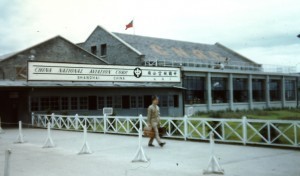
CNAC terminal at Lunghwa Airport
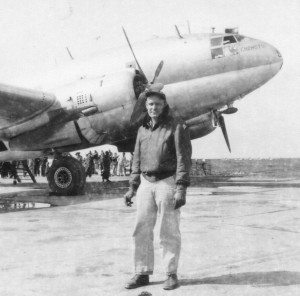
CNAC Captain Felix Smith in front of a C-46
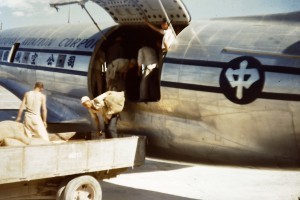
Loading for a rice drop
December 1, 2011
the engine coughed, sputtered twice, and died
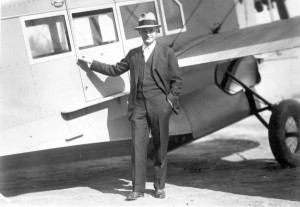
Harry Smith next to the cabin door of a Loening Air Yacht
Moon Chin also copiloted Loening Air Yachts with a pilot named Harry Smith, and one gray, glowering day they left Shanghai and headed for Nanking, their first scheduled stop on the way upriver to Hankow. Smith and Moon Chin flew with their wings brushing the underside of the cloud layer at about five hundred feet. The low clouds held the horizon close, and they passed Soochow on a compass course designed to intersect the Yangtze a few miles west of Nanking. Three or four passengers sat in the cabin beneath, along with C.N.A.C.'s usual three hundred pounds of overload. Moon Chin had the yoke, and he held steady for Nanking. A patchwork of flooded rice paddies slipped beneath the plane. It was a routine flight until the engine coughed, sputtered twice, and died. The radial engine's thunder was replaced by the eerie whoosh of the airstream rushing through the Loening's struts and support wires. Without power, no airplane can maintain level flight, and the Loening's propeller was fixed. It stopped flat across the breeze and acted like a gigantic air brake. From 500 feet the seaplane couldn't glide a mile. They didn't have enough altitude to turn. They had to land straight ahead. Dykes and flooded paddies would have torn a land plane apart, but a Loening might not fare so poorly with a boat hull slung beneath. Smith and Moon dove for a rice paddy straight ahead. Coolie farmers working on the narrow causeways or in the flooded paddies flung their tools and sprinted for safety. Smith flared the plane and stalled it onto the flooded paddy just beyond a dike. The Loening smacked the water and bounced off the muddy bottom and careened across the water with too much momentum to stop in the length of a single paddy. The plane ploughed through a dike into the next paddy and drifted to a stop. Muddy water dripped from the wings and tail. Moon Chin pushed up his goggles and checked the passengers. They looked like they'd seen ghosts, but they weren't harmed.
The two affected farmers splashed through the paddy, yelling about compensation for their wrecked dykes and lost rice. Their peers working neighboring paddies rushed over to oogle the amazing occurrence. A commotion sprang up around the stranded airplane.
Moon Chin, Smith, and their passengers waded to the nearest dike. The passengers hired farmers to carry their luggage, and Harry Smith took them to the nearest railroad station. Moon stayed with the Loening. Smith telegraphed notification to Lunghwa and took the next train to Nanking. Two C.N.A.C. mechanics reached the marooned airplane that afternoon, disassembled it, and hired farmers to load the parts onto rafts, which they floated through the rice paddies to an irrigation canal. They transferred the parts to a junk for the journey down-canal and downriver to Shanghai. A week or ten days later, the plane was back in service. Moon Chin had been back at the airport on the afternoon of the mishap. He didn't miss a single day of work.
(author's interviews with Moon Chin, September 17, 2004; July 15, 2005; April 19, 2006.)
November 29, 2011
Only three things seemed able to hold his interest…
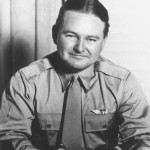
Chuck Sharp
Chuck Sharp is another of the CNAC stalwarts I'd like to introduce. He made his own way to China in 1933 and caught on with CNAC because his 1,000 hours of flight time wasn't enough to land him a job with a stateside airline. He'd stay with CNAC through the end of the Second World War, rising to become Chief Pilot, and then operations manager — a position he held through all the years on The Hump. Famously ferocious in those years, in the beginning, he hadn't been that way at all.
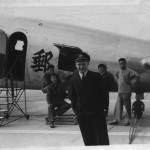
Chuck Sharp and the DC-2 (courtesy of Edward P. Howard)
A roguish imp from Fort Worth, Texas who the other flyers nicknamed "Apple Dumpling" on account of his plump, dimpled cheeks and relentless pursuit of his next laugh, Sharp had a fiery temper, a tall man's swagger, and only three things seemed able to hold his interest: they either wore skirts and heels, held cards and cocktails, or had wings and engines.
Sharp joined C.N.A.C. in April, 1933, two months after Moon Chin, but he was a few years older, and he brought much more flying experience with him to China and Sharp soon checked out as pilot captain.
In 1934, William Bond and Ernie Allison assigned Moon Chin to copilot Loening Air Yachts on the Yangtze River with Chuck Sharp.
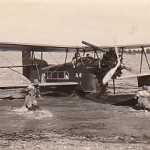
The Loening Air Yacht
When it was on the water, the Loening Air Yacht rode nose high. Until it had enough speed to "get on the step" (that portion of a flying boat's takeoff run when it was hydroplaning in flying attitude with its nose level and its hull not quite lifted free of the water), the pilots couldn't see over the engine unless they were standing on the rudder pedals. Chuck Sharp and Moon Chin were both shorter fellows, however. They couldn't see over the engine even when they were standing on the pedals. To compensate, Sharp hung his head out left, Moon Chin hung his head out right, and they zigzagged to check the river ahead.
The pair took a Loening upriver one cold autumn day. As scheduled, they stopped at Nanking and continued to Anking, the capital of Anhwei Province, a city that had been wrecked by the Taiping Rebellion sixty years before. Behind the waterfront, much of it still lay in ruins. After landing, Sharp taxied toward C.N.A.C.'s 55-gallon mooring barrel anchored in front of the city. Moon Chin climbed onto the lower wing and lay on his belly, ready to catch the rope coiled atop the barrel. The prop wash doused him with spray. Sharp approached the barrel from upstream, traveling with the current, but against a stiff upstream wind. Everything went fine until the wind dropped. The current gave the Loening a sudden jolt of speed. Moon Chin snatched the mooring rope from the barrel top just as it disappeared under the wing, which whacked hard against the barrel. The rope ran out its full length and whipped from Moon's frozen hands before he had a chance to secure it.
Sharp made a perfect second approach, and Moon Chin secured the flying boat without trouble. Furious with himself, Sharp ducked his head under the wing to check the damage. Barrel impact had broken the tip of the aileron horn, a metal bar poking out of the control surface to which cables were attached to move the aileron. Without a functioning aileron, the plane wouldn't turn properly in the air, a serious problem. C.N.A.C.'s nearest mechanic was at Hankow, two hundred and fifteen miles upstream, past their next stop at Kiukiang. Sharp rigged a fix with baling wire and a pair of pliers.
Moon Chin eyed the repair with a raised eyebrow.
"If you don't like it, stay here and I'll pick you up on the way back tomorrow," Sharp snapped.
Moon Chin made the flight. They reached Hankow without incident, although the passengers presumably didn't know they were being steered by baling wire.
November 21, 2011
Hugh Leslie Woods and a favor for the U.S. Navy
Having introduced CNAC stalwarts William Langhorne Bond, Moon Fun Chin, and Ernie Allison over the last year, I'd like to introduce a few more in the coming days — Hugh Leslie Woods, Charles "Chuck" Sharp, and Harold M. Bixby — and pepper in a few of my favorite out-takes (one of which is included below).
First, Hugh Leslie Woods, known to most as "Woody." A reserved and handsome man with thick, bushy eyebrows and the square jaw of a ship's captain, Woods hailed from Winfield, Kansas. He came to China with the Pan Am Expedition of 1933, and he would spend the next thirteen years of his life in Asia. In 1938, he gained the unwanted distinction of being the pilot of the first commercial airliner in history ever to be shot down by hostile air action. (He was piloting a CNAC DC-2 leaving of Hong Kong, and it's a major scene in China's Wings.)
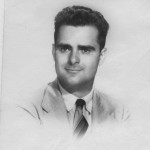
Hugh Leslie Woods, 1938 (courtesy of Shirley Wilke Mosley)
Woods had many other adventures along the way, one of which occurred in the early days of his service in China, when Woods did a clandestine favor for the U.S. Navy's Yangtze River Patrol that turned him into an unsung navy hero.
One day, Woody landed his Loening on the Yangtze at Chungking at the end of a routine flight up through the Yangtze Gorges from Hankow (modern day Wuhan). He was supervising a gang of coolies tying his seaplane to the company pontoon when a motorboat from U.S.S. Monocacy, one of the Navy's shallow-draft Yangtze gunboats, roared up to the dock, crewed by two sour-faced enlisted men. A harried officer leapt to the dock and took Woody aside. He asked if Woody would do the Navy a favor. A man in Hankow would deliver a small package to Woody's quarters. Could Woods please bring it to Chungking on his next flight? Two other delivery attempts had failed.
Woody swallowed his irritation and agreed. Back in Hankow, an errand boy delivered a wrapped package to Woody's apartment, and, as promised, it was only six or eight inches square, and it weighed about a pound. Woody flew the package to Chungking as "pidgin cargo" without disturbing the wrapping.
The young officer met him at the C.N.A.C. pontoon. "Do you have it?" he demanded.
Woody handed over the package.
"Thank God," said the Navy man. "You have our unofficial thanks."
"What the heck is it?" Woody asked, imagining serums or vaccines, some critical medicine.
"Condoms. We had to bar the men from going ashore. Damn near had a mutiny."



